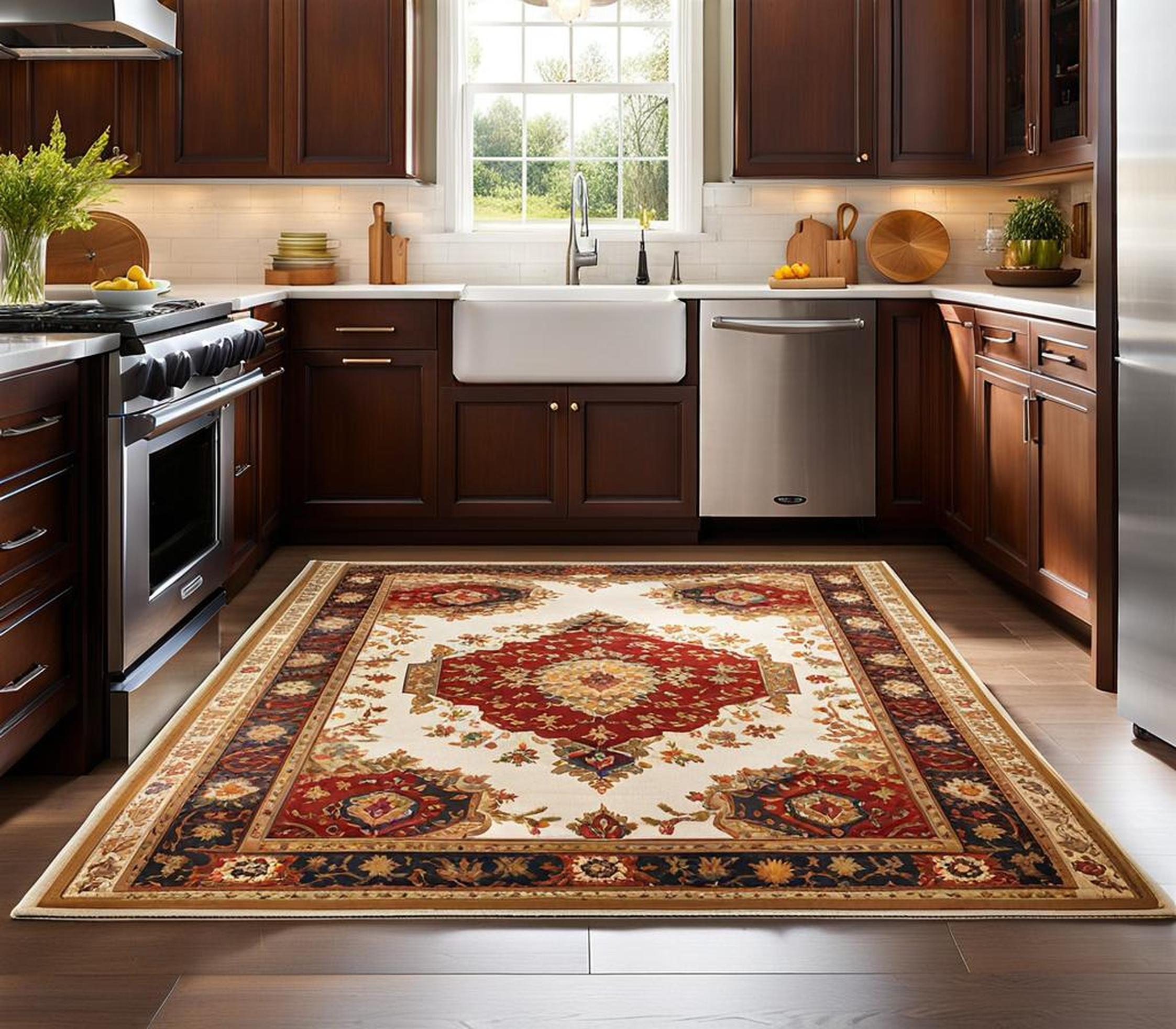A rug is an integral design element that brings warmth and personality to any space. This is especially true in the kitchen, where a beautiful rug helps create an inviting atmosphere around areas that see heavy foot traffic, like the sink.
Choosing the perfect kitchen sink rug entails balancing aesthetic appeal with functionality. The right rug will withstand water, stains, and wear and tear while complementing your existing decor.

Determine the Correct Size
When deciding on a kitchen rug, getting the dimensions right is key. Measure the floor area surrounding the sink appliances to find a rug that offers full coverage without extending too far under appliances or leaving awkward gaps.
For most kitchen sinks, a medium rectangular rug around 4 x 6 feet or a round rug 5 feet in diameter provides ample coverage without getting in the way. However, if you have a large, far-reaching kitchen, sizes up to 8 x 10 feet work nicely.
Optimal Shape and Dimensions for Full Coverage
Consider the existing shapes and lines in your kitchen when selecting rug form. Rectangular rugs parallel the geometry found in most kitchens. Round rugs create a relaxed aesthetic and provide a literal “center” for the space.
Make sure to measure any existing furniture or features to determine ideal proportions. You want your rug size and layout to define and unite the whole sink area.
Extend Under Appliances or Leave Open Floor
Decide whether you want your kitchen rug to slip partially under nearby appliances, like the fridge, cabinets, and trash bins. Although this helps consolidate the look of the space, it can complicate shifting appliances to clean.
Leaving negative space between rug edges and fixed elements creates separation. It also enables easier floor cleaning but may interrupt the cohesiveness of your kitchen’s layout.
Evaluate Materials for Durability and Easy Cleaning
Kitchens are prone to spills, splatters, dripping liquids, and food debris. Assess fiber makeup to discover rug materials that withstand daily wear-and-tear while cleaning up nicely.
| Absorbent Fibers | Repels Water & Stains |
| Cotton | Synthetic Fibers: Polyester, Polypropylene |
| Wool | Natural Fibers: Seagrass, Jute, Sisal |
| Microfiber | Low Pile Height |
The best kitchen rugs feature tightly woven constructions with infrequent, low-profile fibers that liquids can’t easily penetrate. Flatweaves and short, dense piles are ideal.
Assess Different Textures and Constructions
A rug’s texture influences its water-wicking abilities. Tightly braided and flatwoven rugs with smooth surfaces tend to repel liquid better than high, squishy piles.
Examine the underside to understand construction. Well-made rugs should have tightly packed foundations for durability with no loose strands or obvious gaps along the edges.
Add Safety with Non-Slip Backing
A quality non-slip rug pad is crucial for kitchen placements, preventing sliding on slick floors or rug bunching/buckling over time. Choose a grippy rubber or felt pad sized to the rug’s dimensions or opt for rugs with pre-attached non-slip backings.
For the safest footing, combine dual-sided tape strips under edges with an anti-slip pad covering the rug’s entirety underneath.
Make a Design Statement
While material construction plays a major role, don’t underestimate the style factor! The right kitchen rug pulls together your existing decor while adding a splash of color or introducing eye-catching designs.
Solid, Patterned, Colorful
For contemporary kitchen schemes, graphic prints and global motifs enliven hard surfaces. In traditional spaces, Oriental patterns harmonize with classic motifs. Florals, geometrics, and stripes offer timeless appeal.
Color-wise, lively accent shades energize neutral palettes. Go bold with crimson, electric blue, or chartreuse. Muted earth tones like peach and sage green exude subtle sophistication.
Complement Cabinets and Counters
Aim to complement existing paint colors and materials through rug color and pattern. Warm metallic finishes like bronze and copper reflect light beautifully against dark cabinetry. Intricate Moroccan trellis patterns or colorful Kilim designs enliven all-white schemes.
Matching the rug to appliances provides another avenue for pulling the whole space together. For example, stainless steel calls for light, neutral-hued rugs to prevent a sterile, ultra-modern look.
Care and Maintenance
Kitchen rugs reside in demanding settings. Learn specialized cleaning approaches based on fiber content to tackle stains or wear-and-tear over time.
Routinely shaking debris off outside plus spot-treating spills helps sustain appearance and extends lifespan. Rotate kitchen rugs seasonally to distribute effects of heavy traffic and strong lighting.
Budget-Friendly Options Under $100
Affordable kitchen sink rugs still check the non-slip durability boxes. Focus on easy-cleaning cotton, polyester, or polypropylene at these compact dimensions.
Scope out overstock sales online or big-box stores for marked-down neutral solids in 2′ x 3′ to 5′ x 8′ sizes. Search terms like “kitchen mats” and “vinyl rug runners” produce budget-friendly finds.
Splurge-Worthy $200+ Rugs
For investment-level rugs, bump up the quality with handmade, natural fiber constructions sized 8′ x 10′ and above. Opt for custom dimensions or commission a rug pad perfectly sized to your existing kitchen layout.
Premium textures like wool offer unmatched comfort and insulation too. Just be vigilant about blotting spills quickly before they set.
Finding that “just right” rug to anchor your kitchen is a rewarding challenge. Keeping key criteria like size, safety, low-maintenance materials, and design in mind helps narrow the options.
Most importantly, choose a rug that showcases your personal style while standing up to the sink zone’s messy potential. With the right rug, this high-traffic area transforms into an inviting, worry-free space for food prep and cleaning up.
